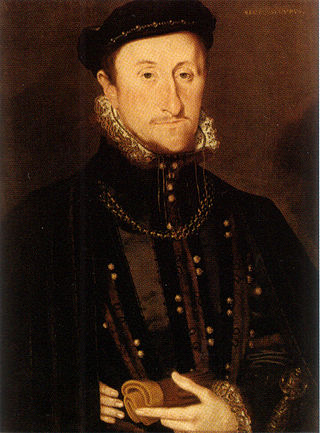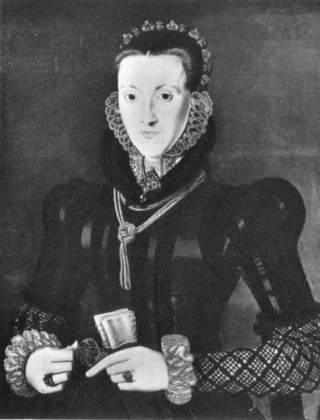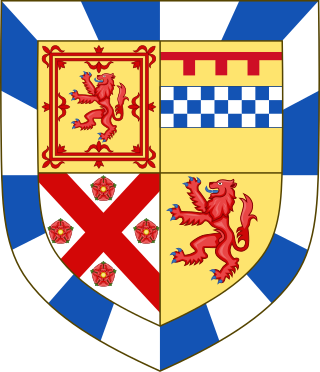
James Stewart, 1st Earl of Moray was a member of the House of Stewart as the illegitimate son of King James V of Scotland. At times a supporter of his half-sister Mary, Queen of Scots, he was the regent of Scotland for his half-nephew, the infant King James VI, from 1567 until his assassination in 1570. He was the first head of government to be assassinated with a firearm.
Archibald Campbell, 4th Earl of Argyll or Archibald "the Red" Campbell, was a Scottish nobleman and politician.

James Hamilton, 3rd Earl of Arran (1537–1609) was a Scottish nobleman and soldier who opposed the French-dominated regency during the Scottish Reformation. He was the eldest son of James Hamilton, Duke of Châtellerault, sometime regent of Scotland. He was of royal descent, and at times was third or fourth in succession to the Scottish crown; several royal marriages were proposed for him, but he eventually never married. He went to France with Mary, Queen of Scots, where he commanded the Scots Guards. After returning to Scotland, he became a leader of the Protestant party against Mary and her French supporters. However, he went insane in 1562 and was confined for the rest of his life.

Archibald Douglas, 6th Earl of Angus was a Scottish nobleman active during the reigns of James V and Mary, Queen of Scots. He was the son of George, Master of Angus, who was killed at the Battle of Flodden, and succeeded as Earl of Angus on the death of his grandfather, Archibald.
Adam Hepburn, 2nd Earl of Bothwell was a Scottish nobleman, who succeeded his father Patrick Hepburn, 1st Earl of Bothwell in 1508. Prior to that, he was known by one of his territorial designations, Adam Hepburn of Crags, under which he drew up his Testament.

James Hamilton, 1st Earl of Arran and 2nd Lord Hamilton was a Scottish nobleman, naval commander and first cousin of James IV of Scotland. He also served as the 9th Lord High Admiral of Scotland.
James Stewart, 1st Earl of Buchan (1442–1499) was a Scottish noble. He was the uncle of James III of Scotland who granted him the Earldom of Buchan. Buchan repaid his nephew by fighting for his cause against rebellious southern barons. Through his marriage to Margaret Ogilvy he acquired the title Lord Auchterhouse.
Robert Stewart, 1st Earl of Orkney and Lord of Zetland (Shetland) was a recognised illegitimate son of James V, King of Scotland, and his mistress Eupheme Elphinstone. Robert Stewart was half-brother to Mary, Queen of Scots and uncle to James VI and I of Scotland and England.

Archibald Douglas, Earl of Douglas and Wigtown, Lord of Galloway, Douglas and Bothwell, called Archibald the Grim or Black Archibald, was a late medieval Scottish nobleman. Archibald was the bastard son of Sir James "the Black" Douglas, Robert I's trusted lieutenant, and an unknown mother. A first cousin of William 1st Earl of Douglas, he inherited the earldom of Douglas and its entailed estates as the third earl following the death without legitimate issue of James 2nd Earl of Douglas at the Battle of Otterburn.
Janet Kennedy, was a Scottish noble and the mistress of King James IV of Scotland.
Elizabeth Keith, Countess of Huntly, was a Scottish noblewoman and the wife of George Gordon, 4th Earl of Huntly, Scotland's leading Catholic magnate during the reign of Mary, Queen of Scots. In 1562, Elizabeth encouraged her husband to raise forces against Queen Mary which led to his being outlawed, and after his death, his titles forfeited to the Crown. Elizabeth's son Sir John Gordon was executed for having taken part in his father's rebellion.

Jean Gordon, Countess of Bothwell was a wealthy Scottish noblewoman and the second wife of James Hepburn, 4th Earl of Bothwell. He became, after his divorce from Lady Jean, the third husband of Mary, Queen of Scots. Lady Jean herself had a total of three husbands. Upon her second marriage, she became the Countess of Sutherland.

Agnes Keith, Countess of Moray was a Scottish noblewoman. She was the wife of James Stewart, 1st Earl of Moray, regent of Scotland and the illegitimate half-brother of Mary, Queen of Scots, making her a sister-in-law of the Scottish queen. As the wife of the regent, Agnes was the most powerful woman in Scotland from 1567 until her husband's assassination in 1570.
Anne Hamilton, Countess of Huntly, was a Scottish noblewoman and a member of the powerful Hamilton family which had a strong claim to the Scottish crown. Her father James Hamilton, Duke of Châtellerault, 2nd Earl of Arran was heir presumptive to the throne of Scotland after Mary, Queen of Scots prior to the birth of the latter's son Prince James in 1566. Anne was the wife of George Gordon, 5th Earl of Huntly, Lord Chancellor of Scotland and a chief conspirator during the reign of Queen Mary.

Jean Hepburn, Lady Darnley, Mistress of Caithness, Lady Morham was a Scottish noblewoman and a member of the Border clan of Hepburn. Her brother was James Hepburn, Earl of Bothwell, the third husband of Mary, Queen of Scots. Jean's first husband was John Stewart, 1st Lord Darnley, an illegitimate half-brother of Queen Mary, which made Jean a double sister-in-law of the queen. Jean married three times. She was also Lady of Morham, having received in 1573 the barony of Morham and lands which had belonged to her mother, Lady Agnes Sinclair and was forfeited to the Crown subsequent to her brother, the Earl of Bothwell's attainder for treason.
Robert Maxwell, 5th Lord Maxwell was a member of the Council of Regency (1536) of the Kingdom of Scotland, Regent of the Isle of Arran and like his father before him patriarch of the House of Maxwell/Clan Maxwell. A distinguished Scottish nobleman, politician, soldier and in 1513 Lord High Admiral, Lord Maxwell was a member of James V of Scotland's royal council and served as Lord Provost of Edinburgh in 1524, 1527 and 1535. He was also an Extraordinary Lord of Session in 1533. In 1537, he was one of the ambassadors sent to the French Court to negotiate the marriage of James to Mary of Guise, whom he espoused as proxy for the King.

George Hay, 7th Earl of ErrollPC was a Scottish nobleman and politician.
Alexander Home, 3rd Lord Home was a Scottish soldier and nobleman, Chamberlain of Scotland and Warden of the Eastern March. He fought at the Battle of Flodden where his forces defeated the English right wing before the Scottish army was destroyed. After the battle, he resisted the regency of John Stewart, Duke of Albany and was captured and executed for rebellion.

Andrew Stewart, 2nd Lord Ochiltree fought for the Scottish Reformation. His daughter married John Knox and he played a part in the defeat of Mary, Queen of Scots at the battle of Langside.
James Lindsay, 7th Lord Lindsay PC, Scottish landowner who was a gentleman of King James's bedchamber.









